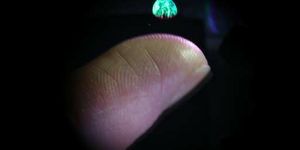These Tiny Wires Deliver Drugs Directly to the Brain
Getting medication to the brain can be a tricky business. The blood-brain-barrier is designed to prevent toxic substances in the bloodstream from reaching delicate brain tissue. The problem is that it also keeps drugs that can destroy cancer from getting to tumors. Surgery for brain injuries and medications for diseases like Alzheimer's or Parkinson's are not always effective but getting tiny doses of medicine to regions of the brain that are difficult to access is crucial.
MIT researchers have come up with a possible solution, with a miniaturized dosing system that can get small amounts of drugs to an area of brain tissue barely one cubic millimeter in size. Since some diseases of the brain impact only a portion of tissue, being able to target these small sections, without damaging healthy tissue, could be a boon to thousands of patients.
The device consists of a needle about as thin as one human hair. Contained in it are several small tubes. The device was tested in lab rats, and the researchers were able to deliver doses of a drug to the animals in one precise area of the brain, and those doses were accurately placed and enough to impact the rat's motor function. More than one drug can put into the brain at the time and delivered to different locations.
Canan Dagdeviren, the LG Electronics Career Development Assistant Professor of Media Arts and Science is the lead author on the paper and explained, "We can infuse very small amounts of multiple drugs compared to what we can do intravenously or orally, and also manipulate behavioral changes through drug infusion. Senior author on the paper Robert Langer added, "We believe this tiny microfabricated device could have a tremendous impact in understanding brain diseases, as well as providing new ways of delivering biopharmaceuticals and performing biosensing in the brain."
Targeting specific brain areas is necessary because some medications like l-dopa which is used to treat Parkinson's and SSRI drugs like Prozac for depression, are taken orally and then eventually wind up circulating through the entire brain, when they would be much more efficient if they could be deployed directly to the cells and neurotransmitters involved in those disorders.
Once the cannula with the tubes is placed into the brain, it's connected to a pump that is usually implanted under the skin, somewhere on the body. In one part of the study, the researchers were able to use the system to deliver a drug, muscimol, which induces Parkinson's-like movements in mice. The dose was barely a few nanoliters to an area called the substantia nigra, which is located deep in the brain and not accessible by other means. The team was also able to reverse the effects of the muscimol by running saline through the device and washing the drug away.
Going forward, the team hopes that because the device is so customizable, being able to deliver different drugs to different locations and even being a conduit for transmitting light into the brain for optogenetics, it will have multiple applications in patients with brain disease, injury or mental health issues. The device, called MiNDS for Miniaturized neural system for chronic, local intracerebral drug delivery, might be tiny, but it offers an enormous opportunity for researchers and patients. The video below talks about the study and the device, take a look at what a small bit of wire could mean for neuroscience.
Sources: MIT, Washington Post, Science Translational Medicine









